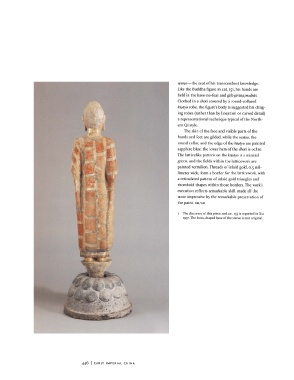Page 447 - The Golden Age of Chinese Archaeology: Celebrated Discoveries from the People’s Republic of China
P. 447
usnisa—the seat of his transcendent knowledge.
Like the Buddha figure in cat. 151, his hands are
held in the have-no-fear and gift-giving mudras.
Clothed in a dhoti covered by a round-collared
kasaya robe, the figure's body is suggested his cling-
ing robes (rather than by lineation or carved detail)
a representational technique typical of the North-
ern Qi style.
The skin of the face and visible parts of the
hands and feet are gilded, while the usnisa, the
round collar, and the edge of the kasaya are painted
sapphire blue; the lower hem of the dhoti is ochre.
The latticelike pattern on the kasaya is a mineral
green, and the fields within the latticework are
painted vermilion. Threads of inlaid gold, 0.5 mil-
limeter wide, form a border for the latticework, with
a reticulated pattern of inlaid gold triangles and
rhomboid shapes within those borders. The work's
execution reflects remarkable skill, made all the
more impressive by the remarkable preservation of
the paint. XM/AD
i The discovery of this piece and cat. 153 is reported in Xia
1997. The lotus-shaped base of the statue is not original.
446 | E A R L Y I M P E R I A L C H I N A

